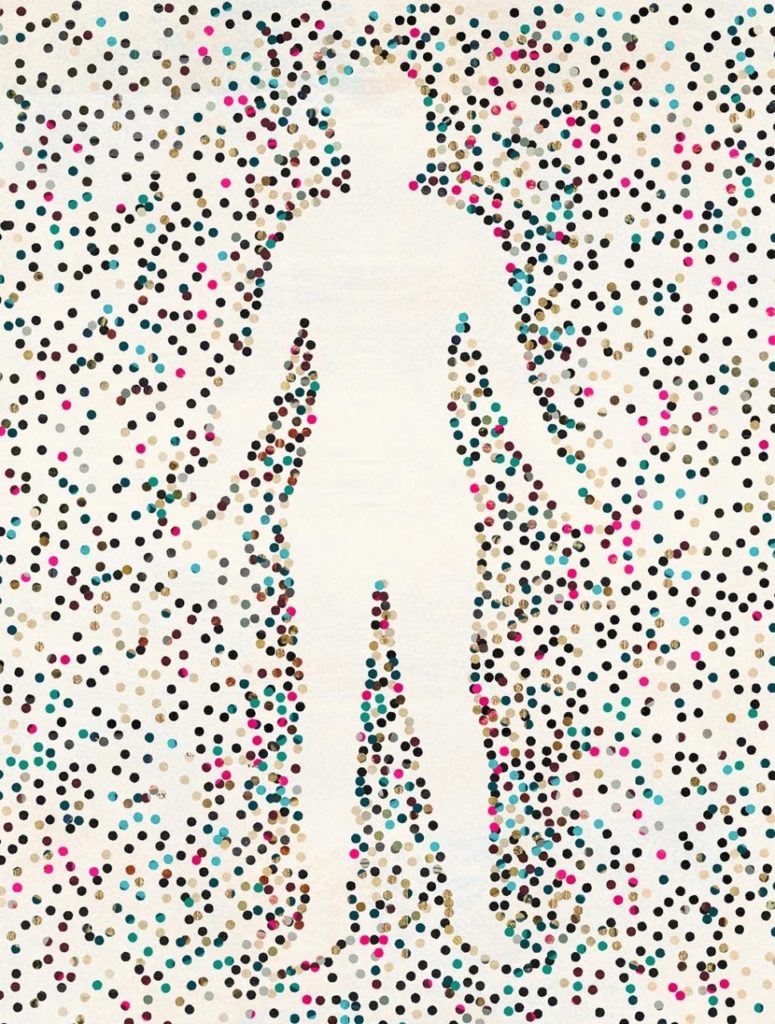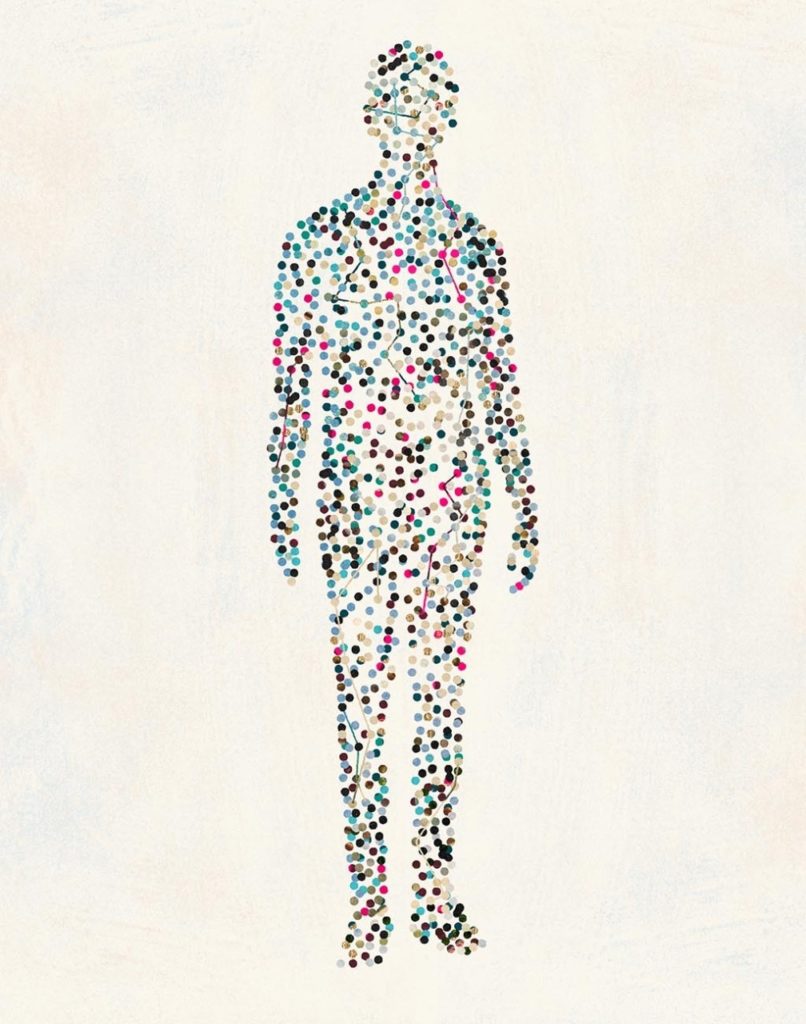Reimagining survival
Better cancer diagnostics and treatments are in the works

Cancer is a disease of the ages. For 4,000 years, humans have noted its destructive effects. Hippocrates dubbed the enemy Karkinos, for crab, because cancerous tumors are often firmly embedded in normal tissue, surrounded by “legs” of snaking blood vessels that deliver nutrients and oxygen. Pervasive, invasive and deadly, cancer is the second leading cause of death in the United States.
We have only recently found the means to fight back. Chemotherapy and radiation first arrived in the mid-1900s; President Richard Nixon declared a war on cancer in 1971, establishing the National Cancer Institute and increasing research funding. We’ve seen a slow march forward with small but meaningful victories since.
Between 1991 and 2015, overall cancer mortality dropped by 26%, primarily a result of better screening techniques that allow earlier diagnosis of cancers before they have spread to other parts of the body.
Unlike in Hippocrates’ time, cancer is no longer necessarily a death sentence. On the contrary, many clinicians liken some types to more of a chronic disease similar to diabetes. Ongoing monitoring coupled with the availability of new drug combinations can keep the disease in check for many people.
Now researchers are setting their sights on a more difficult problem — not just managing but actually curing advanced cancers. To do so, they often leverage the immune system, priming it to recognize and seek out cancer cells throughout the body by using genetically engineered CAR-T cells, for example, or by targeting tumors with agents to ramp up immune cell activity.
Specially engineered antibodies are being tested in clinical trials for their ability to recognize and obscure molecules that protect cancer cells — so immune cells can gobble the cancer cells up.
They’re also advancing diagnostic techniques so more cancers can be caught earlier. They’re learning how to analyze minute quantities of free-floating DNA in the blood, seeking cancer indicators in the molecular backwash released when a tissue sample is blasted with a high-energy ion beam, and tweaking imaging techniques to reveal the basic details of early tumor biology.
“In biomedicine, we’re faced all the time with intractable problems, and cancer is one of these problems that is very difficult to solve,” said biochemistry professor Steven Artandi, MD, PhD, the Jerome and Daisy Low Gilbert Professor and the Laurie Kraus Lacob Director of the Stanford Cancer Institute. “Often these problems are solved by thinking about them in a completely different perspective, and that’s the kind of attitude and approach that we foster at Stanford.”
Read on to learn about some of the diagnostic tools and treatments that are on the horizon.
New diagnostic tools
Tumor scraps
Researchers are analyzing molecules that latch on to DNA to reveal clues about the underpinnings of cancer.
Like all tissues, tumors shed bits of themselves into the bloodstream. Cells that slough from a mass are often the first harbinger of cancerous tissue. Loose snippets of DNA also provide a wealth of information about the tumor from which they parted, sometimes down to the very mutation that caused the tumor in the first place.
These floating fragments are known as cell-free DNA, and Christina Curtis, PhD, associate professor of medicine and of genetics, is keen on understanding how they inform both ends of the cancer research spectrum — detection and treatment. The problem is that nascent tumors don’t shed much DNA. Even when they do, finding rare genetic clues in a blood draw is, at best, unlikely.
Curtis and her team are taking a slightly different approach. “We’re finding value in all sorts of cell-free DNA, not just that born of tumor cells,” she said. “Instead of leaning solely on the genetic information found in cell-free DNA, we’re looking at something called epigenomics.” Roughly, epigenomics translates to “on” or “near” the genome, which makes sense — epigenomics is the study of molecules that latch on to parts of the genome to change or guide function.
Epigenomics provides a window into the molecular ecosystems of the entire body. There are millions of components in the epigenome that create patterns, revealing what’s going on. For example, when someone falls ill, epigenomic molecules in immune cells begin to shift — some might latch on to the DNA while others fall off.
“Blood analysis shows changes in epigenomic markers, allowing us to potentially read out things like immune activation, or inflammation,” said Curtis. And because epigenomic information can come from more than just tumor cell-free DNA, it’s a more plentiful data source. “We’re surveying everything that’s shed into the blood.”
The idea is to identify patterns — epigenomic signatures — that are linked to different states of the body, including cancer. It’s not the same as an official diagnosis, but the tactic would aid in early cancer detection by prompting appropriate follow-up.
Curtis also sees potential for epigenomic analysis in monitoring patient responses to immune-based cancer treatments. “We could use this approach to assess how the body is responding to new immunotherapies on a systematic level and see if the therapy is actually working,” she said.
“Cancer is ever evolving, and we need to find ways to be one step ahead. It’s still early days, but epigenomic changes in cell-free DNA give us another way to read that out and — hopefully — keep us one step ahead.”
Nothing wasted
First there was the smartphone, then the smartwatch — now scientists at Stanford have created a smart toilet, detecting diseases through data that’s usually discarded.
Stanford scientist Sanjiv “Sam” Gambhir, MD, PhD, has dedicated much of his career to detecting disease before it strikes. Now, he’s created something that does the dirty work for him: a tech-wielding toilet that automatically monitors urine and stool for signs of disease.
Gambhir’s conception of this smart toilet dates back more than 15 years. “When I told people about it, they’d laugh a little because it’s kind of an odd idea,” he said. Offbeat though it may be, the smart toilet is part of an arsenal of technologies Gambhir has spearheaded to detect cancer and other diseases at the earliest stage possible.
The big idea is to collect, sample and analyze data that otherwise heads straight for the sewers. Urine gets one set of tests, stool another, and if the toilet detects anything suspicious — such as blood in the urine, which can be a sign of bladder cancer — it sends an alert to that person’s doctor. It even knows who’s using the toilet through a couple of identification systems, such as a flush button that reads fingerprints.

Inside the smart toilet is a sort of miniature automated lab: Sensors detect whether the incoming “data” is urine or stool, allowing the toilet to execute the correct sample analysis. The appropriate disease-detecting tests are then administered, followed by one of two types of analysis: molecular, which hunts for various biomarkers; and phenotypic, which identifies physical attributes of the urine or stool, such as flow and consistency. The tests and analysis processes can even be personalized.
“If you’re at risk for kidney cancer, you’d likely be monitored differently than someone who’s at risk for prostate cancer,” said Gambhir, professor and chair of radiology and the Virginia and D.K. Ludwig Professor of Cancer Research. Recently, Gambhir and his team completed the first clinical trial of the smart toilet, showing its utility in flagging suspicious biomarkers or signs of disease. The key, Gambhir said, is that the user doesn’t have to do anything special. “Everyone uses the bathroom,” he said. “It’s the perfect way to measure health parameters without the person having to do anything differently.”
Now, Gambhir and his team are revising the latest prototype into a compact accessory, fit for any toilet. “No one wants to rip out their old toilet and replace it,” he said. “So we’re making the ‘smart’ aspect of the toilet into more of a bidet-type add-on.”
The proof is in the particulate
By shooting beams of oxygen toward tissue samples, scientists are trying to piece together an in-depth picture of cancer’s molecular secrets.
Imagine a scene from a sci-fi movie where a beam of energy streams toward Earth and strikes the ground, sending a cloud of dirt and particulate matter skyward. An imaging tool devised by scientists at Stanford operates on much the same premise. It’s called multiplexed ion beam imaging, or MIBI, and the burst of particulate matter in this case is used to detect and measure levels of certain molecules — such as those that flag cancer — in a cell.
“We want to get more granular by studying single cells and substructures inside those cells that could inform clinical decisions,” said Sizun Jiang, PhD, a postdoctoral scholar who works with MIBI, the brainchild of immunologist Garry Nolan, PhD, the Rachford and Carlota Harris Professor, and Michael Angelo, MD, PhD, assistant professor of pathology.
Traditional imaging techniques allow scientists to see whether immune cells have infiltrated a tumor, but MIBI, which was further developed at a company founded by Nolan and Angelo, takes it a level deeper, revealing details such as immune cell type and the specific cancer-fighting function the cell is executing.
Molecular imaging has often relied on fluorescence to label proteins and cells. But there are only so many clearly distinct hues, limiting the number of molecules for which one can search. MIBI gets around that by harnessing a tagging system that uses metals that are rare in human biology.
The metals are fused to antibodies, which search for specific molecules in a tissue, such as a cancer marker. If present, the antibody latches on, acting as a flag. To detect the metal markers, the MIBI instrument shoots a beam of oxygen down into a tumor sample. Like a microscopic scene from Independence Day, a plume of tissue erupts, offering itself up for the MIBI detector to inspect for the presence of rare metal.
So far, the group can collect information on up to 50 distinct molecules at a time with the technology — quite a jump from the five to seven that fluorescence provides. That leap paints a more detailed image, but it also allows the researchers to begin to tease apart the molecular interactions fueling tumor formation, growth and, potentially, destruction.
“With MIBI,” said Jiang, “we envision a future where clinicians and data scientists work together to attain a more complete understanding of what’s going on in a tumor, and can use that information to pick the best treatment.”
Live interactions
Researchers are developing technology that makes short movies of cells in tumors of live animals.
A live tumor is a messy place. Cancer cells, immune cells, blood cells and others all mix together, sending and responding to a frenzy of signaling that often represents opposing forces — either aiming to help or hinder tumor growth.
Cancer researchers want to know what those cells are doing and how they interact, but it’s not easily deciphered, especially from a still image or slice of tissue.
“What’s been missing from fundamental cancer biology research is a way to actually see the conversations and interactions between cells,” said Adam de la Zerda, PhD, associate professor of structural biology.
He has built on a technology, called optical coherence tomography or OCT, to fill that niche. The noninvasive imaging technique, often used to inspect the retina during eye exams, offers an expanded window into the world of living tissues, including tumors. De la Zerda has added a twist to the long-established imaging method using gold nanoparticles that, when pooled in a tumor, refract light in a way that enhances detail in the OCT scan.
De la Zerda’s technique doesn’t sleuth out signs of cancer, so it isn’t a tool for early cancer detection — but it could shed light on a host of molecular details that better inform cancer diagnosis overall. By fusing gold particles to antibodies, the particles can even be sent to a particular cell or protein: An antibody will shepherd the gold particle to a specific molecular structure in the body, such as a cancer marker.
“For the first time, we’re able to actually see the cells traveling around in the tumor, where they go or don’t go, and the other cells they’re interacting with,” said de la Zerda. The method has been used only in mice, but one day could be used to show how immune cells infiltrate a tumor, informing which treatments work best for specific patients.
The gold nanoparticles are not approved for use in humans, but that’s the goal. The amount needed to visualize a tumor’s specifics is minuscule — “less than what’s consumed in a gold leaf on a fancy chocolate cake,” said de la Zerda.
“We’ve known that there are lymphatic vessels in tumors, but for the first time we’ve been able to show that these vessels are performing a duty and draining the tumors of fluid,” he said. “For us, it’s akin to the difference between finding evidence of water on Mars and actually finding water on Mars.”

New Treatments
Fighting the unknown
Priming the immune system to hunt for cancer throughout the body might eliminate distant metastases and future recurrence.
Vaccinating against cancer may seem too good to be true. In fact, the approach developed by professor of oncology Ronald Levy, MD, isn’t what most of us would think of as a vaccination. Unlike a classical vaccination, which prevents disease before it starts, this one bolsters the body’s battle against disease that already has a foothold.
Levy, who has dedicated his career to fighting blood cancers, injects existing tumors with an agent that gives an activity boost to immune cells called T cells that have infiltrated the cancer and begun to fight it. Often, however, these cells become exhausted in their efforts and tamp down their cancer-fighting activity.
In early 2018, Levy and his colleagues, including instructor of medicine Idit Sagiv-Barfi, PhD, showed that this strategy could eliminate established human tumors in mice not only at the site of injection but also at distant sites throughout the body. The newly reactivated, unleashed T cells could also prevent the future development of mammary tumors in a mouse model of breast cancer.
Since the original mouse study, Levy has launched a series of trials to test the safety and efficacy of the approach in humans. So far the treatment seems safe in humans, and there are hints it may also be effective. Of 29 people with lymphoma enrolled in the initial trial, nearly all saw their tumors at the treated site shrink. Furthermore, 24 also experienced a reduction in tumor volume at distant, untreated sites.
“We’re very encouraged,” said Levy, noting that many other trials around the country are employing variations on the technique. “Our goal is to amplify an immune response that already exists in and around the cancer and use that to fight cancer throughout the body.”
Levy is currently leading three additional trials of the technique — two in patients with lymphoma and one in patients with any type of advanced cancer. He envisions that the approach could be used in combination with surgery or other types of drug therapy.
“This could be a new way of approaching the initial treatment of cancer,” said Levy, the Robert K. and Helen K. Summy Professor of the School of Medicine. “We could treat tumors before surgery to get the immune system to fight small metastases elsewhere in the body we don’t even know of at the time. Theoretically this could be used whenever there is a tumor that we can inject.”
In a flash
Rapid, high-power radiation may eliminate cancers in an instant with less damage to healthy tissue.
Stop. Hold as still as you can. Don’t move a muscle.
It’s harder than you think. Now imagine that your ability to remain immobile is vital to the effectiveness of your cancer treatment.
That’s the situation for patients undergoing radiation to zap tumor cells. Despite the best efforts of patients and their clinicians, there are still variables that can’t be controlled. Your heart will still beat, your intestines will still contract and blood will still pulse through your body.
Radiation oncologists have tried to counter this movement by immobilizing the patient with temporary restraints and delivering the dose as quickly as possible. But new technology may make such concerns a thing of the past. Researchers at Stanford Medicine, including professor of radiation oncology Billy Loo Jr., MD, PhD, and at Stanford’s SLAC National Accelerator Laboratory have devised a linear accelerator capable of rapidly delivering high doses of radiation. The accelerator is known as PHASER (for pluridirectional high-energy agile scanning electron radiotherapy) and the act of delivering the radiation quickly is called FLASH. Together they are likely to shake up the field of radiation oncology.
“The delivery of radiation by PHASER is nearly instant,” Loo said. “Currently, a single high dose of radiation takes about three minutes to deliver; it can take up to 30 minutes for very complex cases. In contrast, the PHASER technology can deliver the same dose in a fraction of a second.”
Because there’s little time for the target area to move around, the delivery of the radiation is much more precise than current methods.
There’s another bonus. “No one expected that delivering the radiation much faster would also reduce the damage to normal tissue,” Loo said. “But surprisingly we are seeing much less collateral damage to normal tissues and organs, without reducing the ability to kill tumors.”
In 2019, Loo and his colleagues showed that mice whose brains have been irradiated with the new rapid technique experienced fewer cognitive problems than mice that received the same dose of standard radiation.
“In many cases we couldn’t tell the difference between mice irradiated with FLASH and the un-irradiated controls,” Loo said. “Anything we can do to reduce radiation damage in humans, particularly in children whose brains are still developing, would be a big win.”
Easy does it
Gentler pretreatment could vastly expand who could benefit from stem cell transplants.
Blood cancers like leukemia or lymphoma arise when blood cells run amok in the body, dividing unchecked and crowding out other important cells of the blood and immune system. For many years, the last-ditch measure to cure these conditions was a hematopoietic stem cell transplant (previously known as a bone marrow transplant). But before healthy cells can be infused, the diseased cells in the bone marrow, where all blood cells originate, must be eliminated.
Until recently, this wholesale elimination of a patient’s blood system was accomplished through a devastating combination of chemotherapy and radiation that kills the cells in the marrow. Although effective, the treatment, known as conditioning, is brutal for patients. For some, like the elderly, the very young or very sick, it’s not even an option.

Could there be a better way? A series of ongoing Stanford studies suggests so.
The studies build upon discoveries in mice made by Agnieszka Czechowicz, MD, PhD, now assistant professor of pediatrics, and Irving Weissman, MD, professor of pathology and director of the Institute for Stem Cell Biology and Regenerative Medicine, that showed that conditioning can instead be done with antibodies that recognize and block the activity of a critical survival protein called CD117 on the surface of blood stem cells. This allowed transplanted donor blood stem cells to engraft with subsequent replacement of the blood and immune system without toxicity.
Under the leadership of Judith Shizuru, MD, PhD, a professor of medicine and pediatrics, and Maria Grazia Roncarolo, MD, the George D. Smith Professor in Stem Cell and Regenerative Medicine, this work is being translated from mice to humans in a clinical trial in children with the rare, fatal genetic disease called severe combined immunodeficiency, also known as “bubble boy disease.”
Subsequent studies by the Stanford researchers have shown that blood stem cells can be eliminated even more effectively with a combination of antibodies against both CD117 and CD47 (a protein expressed by many cancer cells) or by attaching a cell-killing drug to CD117 antibodies. These approaches, in tandem with a cocktail of immune-suppressing antibodies, can even allow mice to accept immunologically mismatched hematopoietic stem cells and tissues.
The findings, which have sparked multiple additional clinical trials, are likely to transform the way hematopoietic stem cell transplants are performed, vastly broadening the pool of patients who could benefit and the range of blood and immune diseases that could be cured by such therapies.
To eat or not to eat
Unleashing immune cells to gobble cancers helps the body fight back.
Macrophages are often the unsung heroes of the immune system. They’re not glamorous like T cells, those highly selective assassins that target specific antigens on the surface of sick cells or microbial invaders. Or like B cells, which, when triggered, churn out millions of similarly specific antibodies to course through our bloodstream and lymphatic system to tag cells for destruction.
Instead, macrophages are part of what’s known as our innate immune system — the infantry that does a lot of the grunt work. Macrophages constantly patrol the body looking for signs that something is amiss. When they recognize a sick or dying cell or a foreign invader, they glom on to and engulf the target like an amoeba with a hapless bacteria snack. They then send out signals to alert T cells to the presence of trouble.
Despite the seeming drudgery of their job, macrophages are increasingly recognized as key players in the development of new immunotherapies. Their post on the immunological front line has brought them to the attention of cancer researchers that include Weissman, the Virginia and D.K. Ludwig Professor for Clinical Investigation in Cancer Research.
In 2009, Weissman’s lab identified the CD47 protein, which is found on the surface of nearly every human cancer studied. CD47 is recognized by a receptor on the surface of macrophages and serves as a “don’t eat me” signal that stops macrophages in their tracks. Blocking this binding with an anti-CD47 antibody releases the brakes on macrophage activity and, in mice, led to the elimination of many human cancers.
Now Weissman and his colleagues, including hematologist Ravi Majeti, MD, PhD, and oncologist Branimir Sikic, MD, who are both professors of medicine, and the company Forty Seven Inc., are conducting early-phase clinical trials of the antibody (in combination with immunotherapy drug rituximab) in people with a variety of cancers.
Results from the first trial, which enrolled 22 people with lymphoma, showed the treatment was well tolerated; some patients saw disease regression. In a second phase-1 trial of 62 people with advanced solid cancers, the treatment was also well tolerated; two people experienced partial remissions.
Seven trials are ongoing of the antibody, known as magrolimab, either alone or in combination with other immunotherapies or chemotherapies. Some of these trials have shown promising results in patients with myelodysplastic syndrome and elderly patients with acute myelogenous leukemia.
At a critical point
From new imaging techniques to revved-up immune systems, it’s apparent that we’re on the verge of making big strides in cancer diagnosis and treatment.
Recently, the American Cancer Society announced that the United States experienced its single biggest drop ever in cancer mortality in 2017.
In particular, deaths from lung cancer and melanoma have declined significantly — a fact hailed by National Cancer Institute Director Norman Sharpless, MD, in a recent talk at Stanford.
“When you have an effective therapy, added to good prevention and good screening, you can really make a difference in these cancers,” Sharpless said.
“We are at a critical point in the history of cancer now,” said Artandi, the Stanford Cancer Institute’s director. “Over the next five years we need to continue with fundamental basic science discoveries in cancer, while translating these findings to our cancer patients by expanding and accelerating our clinical trials. This pipeline bringing new drugs and other therapies to our cancer patients is an essential step in curing patients with cancer.”


